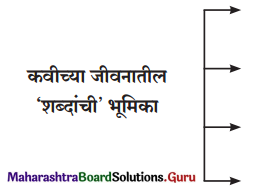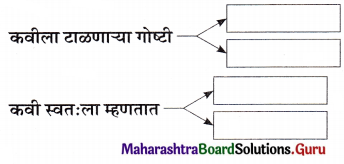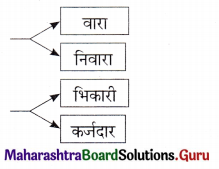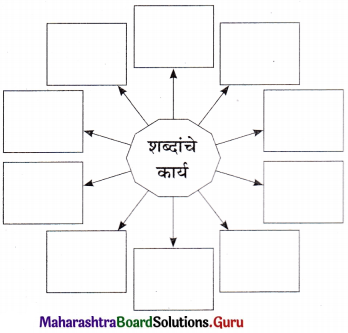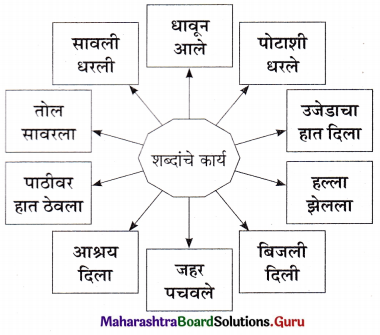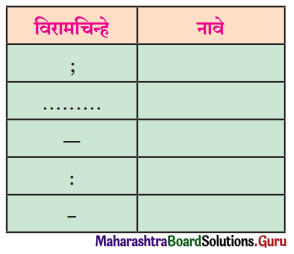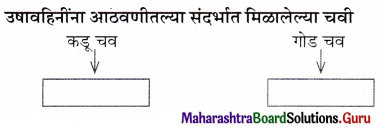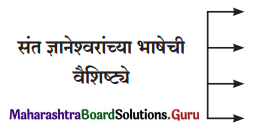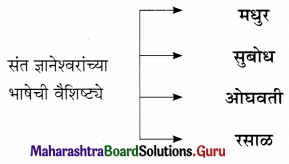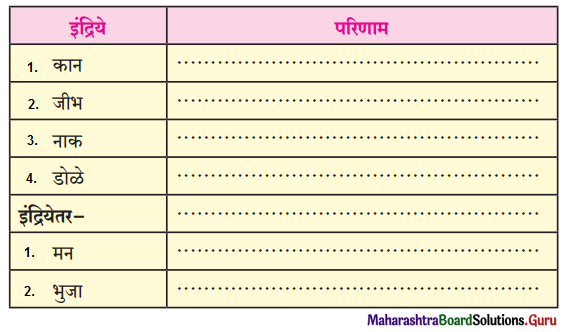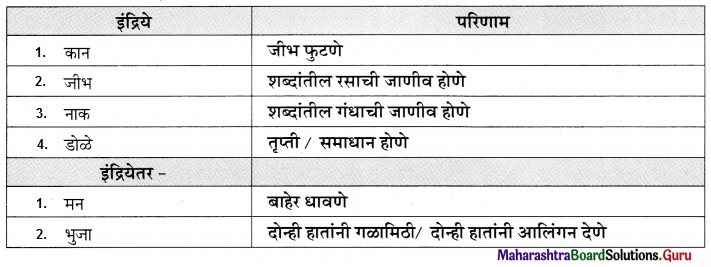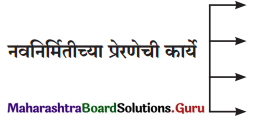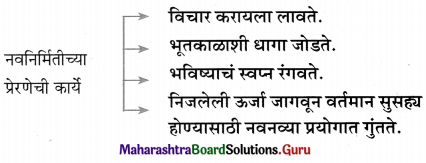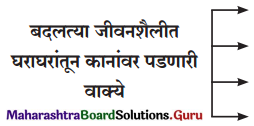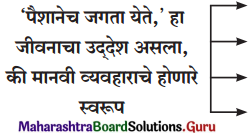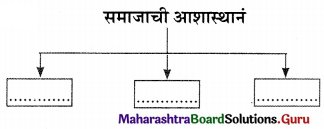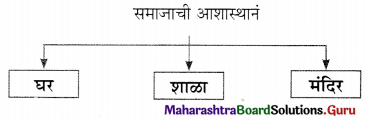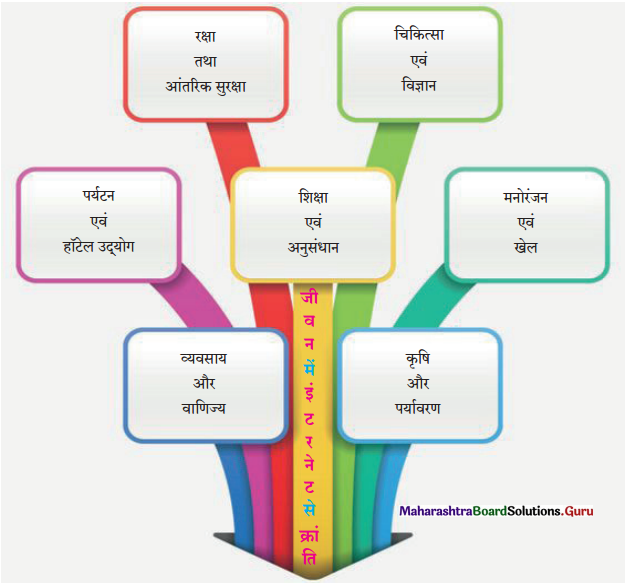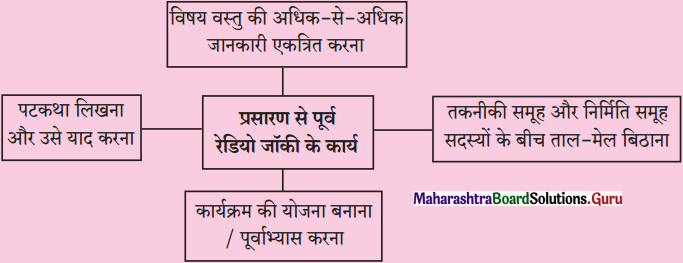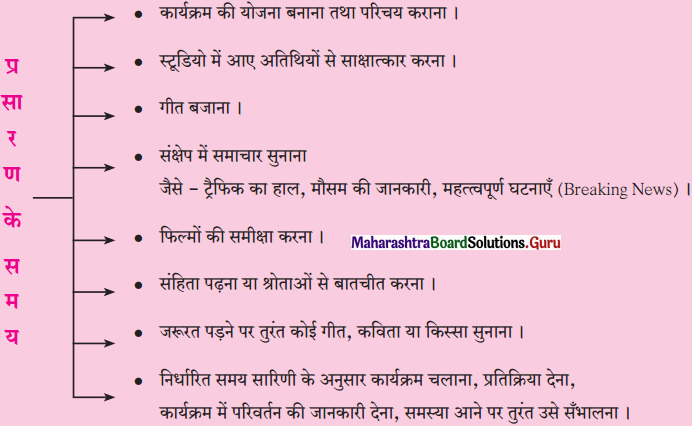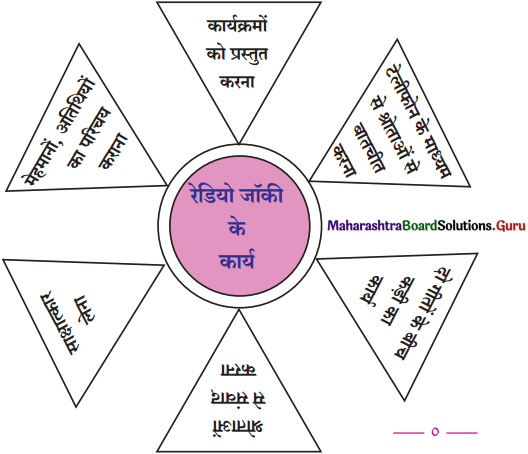11th Marathi Chapter 12 Exercise Question Answer Maharashtra Board
Balbharti Maharashtra State Board Marathi Yuvakbharati 11th Digest Chapter 12 पैंजण Notes, Textbook Exercise Important Questions and Answers.
पैंजण 11 वी मराठी स्वाध्याय प्रश्नांची उत्तरे
11th Marathi Digest Chapter 12 पैंजण Textbook Questions and Answers
कृती
1. योग्य पर्याय निवडून वाक्ये पूर्ण करा.
प्रश्न अ.
आजी जखमांना ऊब देऊन राज करायची! म्हणजे
(१) आजी जखमांना औषधपाणी करून काम करायची.
(२) रूढींचा त्रास सहन करत स्वयंपाकघरापुरती वावरायची.
(३) जखमारूपी संकटांना सहन करून आनंदात राहायची.
उत्तरः
आजी जखमांना ऊब देऊन राज करायची ! म्हणजे – जखमारूपी संकटांना सहन करून आनंदात राहायची.
![]()
प्रश्न आ.
सारे दुर्लक्षून ती राजराणीसारखी भिरभिरायची! म्हणजे
(१) राजाच्या राणीसारखा सन्मान तिला मिळायचा.
(२) राजाच्या राणीचा तोरा मिरवायची.
(३) रूढींच्या मर्यादेत राहून घरापुरत्या निर्णयात सहभागी होण्यात धन्यता मानायची.
उत्तर :
सारे दुर्लक्षून राजाराणीसारखी भिरभिरायची ! म्हणजे – रूढींच्या मर्यादेत राहून घरापुरत्या निर्णयात सहभागी होण्यात धन्यता मानायची.
प्रश्न इ.
मिळणाऱ्या स्वातंत्र्यासाठी मी सारे सहन करते. म्हणजे
(१) घराबाहेर पडण्याच्या स्वातंत्र्यासाठी कौटुंबिक, सामाजिक बंधने सहन करते.
(२) स्वातंत्र्य मिळाले म्हणून इतर दु:खं सहन करते.
(३) ऐच्छिक वेषभूषेसाठी सारे सहन करते.
उत्तर :
मिळणाऱ्या स्वातंत्र्यासाठी मी सारे सहन करते. म्हणजे – घराबाहेर पडण्याच्या स्वातंत्र्यासाठी कौटुंबिक, सामाजिक बंधने सहन करते.
प्रश्न ई.
पायच होऊ देत आता… घट्ट, मजबूत, पोलादी पुढल्या का होईना शतकाआधी! म्हणजे
(१) पुढचे शतक येण्यापूर्वी स्वयंपूर्ण आणि समर्थ बनू दे.
(२) पुढल्या शतकाआधी पाय जमिनीवर राहू दे.
(३) पुढल्या शतकाआधी काटे कमकुवत होऊ दे.
उत्तर :
पुढल्या का होईना शतकाआधी! पायच होऊ देत आता… घट्ट, मजबूत, पोलादी. म्हणजे – पुढचे शतक येण्यापूर्वी स्वयंपूर्ण आणि समर्थ बनू दे.
2.
प्रश्न अ.
खालील ओळींतील संकल्पना स्पष्ट करा.
(१) नादाच्या भुलभुलैय्यातून बाहेर न पडणे.
उत्तर :
संसाराचाही एक नाद असतो. आपल्या पुरुषप्रधान संस्कृतीत संसाराचा नाद बाईलाच शिकवला जातो. त्याची रीतभात सांभाळण्यात बाईचा जन्म जातो. जे आपल्याला पढवलं गेलं त्याच्या पलीकडे जाऊन स्वतंत्र व्यक्ती म्हणून जगण्याची हिंमत बाईने दाखवली तर तिची अवहेलना केली जाते. शक्यतो अशी हिंमत करणाऱ्या स्त्रिया अभावानेच आढळतात. आपल्या संसाराच्या जबाबदाऱ्या पेलताना आपलं पिचणं हा भूलभुलैय्या प्रमाण मानून बाई जगते. त्यात अडकते. त्यातून बाहेर पडत नाही.
(२) पण सारे दुर्लक्षून राजराणीसारखे भिरभिरणे.
उत्तर:
प्राचीन काळापासून कौटुंबिक बंधनात अडकलेली स्त्री शिक्षणाचा परीस स्पर्श होता बदलली. पण तिच्यात झालेले परिवर्तन हे पुन्हा घरापुरतंच मर्यादित राहिलं. तिला स्वयंपाकघरातून गच्चीपर्यंत हिंडण्याचे स्वातंत्र्य दिले गेले. पण ते मिळाल्यामुळे आनंदित झालेली स्त्री अनेक ओझी, बंधनं स्वीकारतच राहिली. आमच्या घरी हे चालत नाही, ते चालत नाही म्हणून घराचं कौतुक सांगताना ती थकली नाही. पण एकीकडे आपल्याला दुसरे कोणतेच स्वातंत्र्य नाही याकडे दुर्लक्ष करून ती मिळालेल्या स्वातंत्र्याचा आनंद घेऊ लागली.
![]()
(३) मिळणाऱ्या स्वातंत्र्यासाठी सारे सहन करणे.
उत्तर :
कवयित्री ही आपल्या आजी, आईला घरात मिळणाऱ्या वागणुकीविषयी कवितेतून भाष्य करते तेव्हा त्या दोघींपेक्षा आपण जास्त सुखी आहोत असं तिला वाटतं. कवयित्री पैंजण, तोरड्या आपल्या पायात घालत नाही. काही बंधनं तिनं झुगारली पण तिनं चपला, बूट, सँडल जवळ केल्या. घर, अंगणाबाहेर पडली.
चपला, बूट, सँडल हे आधुनिकतेचे प्रतीक. आपल्या घराबाहेर पडताना कवयित्रीने या चपला, बूट, सँडल धारण केले. पण तेही तिच्या पायांना साथ देऊ शकले नाहीत. जगताना घराबाहेरची अनेक संकटे ती पेलू लागली. घरात राहताना घरातील संकटे, बंधने तर बाहेर पडली तरी घराबाहेरची संकटे होतीच. पण आर्थिक, निवड स्वातंत्र्यासाठी, स्वतःचे हक्क मिळवण्यासाठी त्या सर्वच संकटांकडे ती दुर्लक्ष करू लागली. पण व्रण तर उमटत राहिले पायांवर, मनावर.
प्रश्न आ.
खालील तक्ता पूर्ण करा.

उत्तरः

प्रश्न इ.
खालील तक्ता पूर्ण करा.

उत्तरः

![]()
3. काव्यसौंदर्य.
प्रश्न अ.
‘चपला घसरतात, सँडल बोचतात, बूट चावतात पण मिळणाऱ्या स्वातंत्र्यासाठी मी सारे सहन करते,’ या ओळींतील विचारसौंदर्य स्पष्ट करा.
उत्तर :
कवयित्री नीलम माणगावे यांच्या पैंजण कवितेत स्त्री स्वातंत्र्याचा विचार मांडला आहे. प्राचीन काळातील स्त्रीचे जगणे ते आधुनिक काळातील स्त्रीचे जगणे यांतील फरक कवयित्री स्पष्ट करते. यात चार पिढ्यांमधील स्त्रीमधील बदलत गेलेले स्वरूप कवयित्री कथन करते.
आजी, आई, मी, मुलगी या चार अवस्थांपैकी मी जी आहे तिचे वर्णन करताना कवयित्री सांगते की ही स्त्री चपला, पायात पैंजण, तोरड्या घालत नाही. तिच्या पायातील चपला घसरतात, सँडल बोचतात, बूट चावतात हे सर्व त्रासदायक असते. या पायताणांचा त्रास होऊन पायाला या गोष्टी बोचत असतात.
कोणतीही एक चप्पल /सँडल कायमस्वरूपी नाही. त्या बदलत जातात पण त्या ज्या पायाला वेदना होतात ते पाय तेच असतात. कामाला ते पाय वणवण फिरतात. पण त्यामुळे तिला बाहेर पडता येतं. तिला काही निर्णय घेता येतात. तिला थोडं आर्थिक स्वातंत्र्य मिळतं पण त्यात ती पूर्णतः पिचूनही जाते.
प्रश्न आ.
‘अगं पायाखालचे काटे मोडण्यासारखे पायच होऊ देत आता… घट्ट, मजबूत, पोलादी’, या ओळींतील अर्थसौंदर्य स्पष्ट करा.
उत्तर :
पुरुषसत्ताक समाजरचनेमध्ये स्त्री आज स्वतःचे स्वतंत्र जग निर्माण करत आहे. आपल्या जीवनातील दुःख दूर करायची असतील तर पुरुषांनी हात दिला तर पुढे जाऊ असा विचार आजची स्त्री करत नाही. ती स्वसामर्थ्यावर विश्वास ठेऊन पुढे जाण्याचा विचार करत आहे. आताच्या काळातील स्त्रीने आपल्या केश, वेशभूषेत कमालीचा बदल केला आहे, इतकेच काय तर आजच्या स्त्रीने दागदागिन्यांचा अव्हेर करत मुक्तपणे जगायला सुरुवात केली आहे.
कवयित्रीच्या मुलीलाही पैंजण, तोरड्या नको आहेत. तिला पायाचे रक्षण करण्याकरता चपला, बूट वगैरेही नको आहेत. त्यांचं घसरणंसदधा तिला नकोय. तिच्या पायाखाली संस्कतीचे, बंधनाचे काटे येणार. ते बोचणारच. ते काटे मोडन काढण्यासाठी तिला तिचे पाय घट्ट, मजबूत, पोलादी करायचे आहेत. स्वत:ला इतकं मजबूत घडवायचंय की कोणाच्या आधाराशिवाय तिला पुढं जाता यायला हवं.
प्रश्न इ.
आजीच्या आणि आईच्या कौटुंबिक वातावरणात झालेला फरक कोणकोणत्या प्रतीकांतून वर्णन केला आहे ते स्पष्ट करा.
उत्तर :
कवयित्री नीलम माणगावे यांच्या पैंजण कवितेत स्त्रियांच्या चार पिढ्या आणि त्यांचे संघर्ष, त्यातून त्यांनी मिळवलेले स्वातंत्र्य याचा विचार मांडला आहे.
कवयित्री या कवितेत मी म्हणून अभिव्यक्त होताना आपल्या आजी आणि आईच्या वाट्याला आलेल्या भोगवट्याचे चित्रण करते. आजी आपल्या पायात दोन किलो वजनाचे पैंजण घालून सम्राज्ञीसारखी ठुमकत फिरायची. त्या ओझ्याने तिचे पाय ठणकून यायचे, जखमा व्हायच्या, रक्त वहायचं पण नादाच्या मोहापायी ते सर्व ती सहन करायची. आपल्या जखमांना ऊब देऊन ती राज करायची. निदान राज करत असलेलं भासवायची.
![]()
संसाराचा गाडा हे पैंजणाचे प्रतीक मानले तर ‘रांधा, वाढा, उष्टी काढा’, एकत्र कुटुंब, त्यांचे मान अपमान, जबाबदाऱ्या या सगळ्यांत तिचं आयुष्य पिचून गेलं, तिच्या पायांना सवयच झाली अनेक जखमा सोसायची. पण त्याच्या विरोधात कधी तक्रार नाही केली. जे आहे त्यात समाधान मानण्याची तयारी होती. कवयित्रीच्या आईने पैंजण घालणे सोडून दिले. नाजूक हलक्या तोरड्या घालायला सुरुवात केली. घरातील सर्वच ठिकाणी ती हिंडू फिरू शकायची.
मधून तोरड्या टोचल्या की साडीचे काठ फाटायचे, दोरे लोंबायचे पण तरीही आपल्याला निदान मुक्तपणे फिरता येते याचा आनंद असायचा. या दोन्ही घरांतील फरक स्पष्ट करण्याकरता काही प्रतीकांचा वापर केला आहे. पैंजण – घरातील प्रचंड जबाबदाऱ्या, स्वयंपाक घरातून माजघरात – केवळ मर्यादित विश्व, सम्राज्ञी – एक प्रकारे गुलामच पण तरी स्वयंपाकघर, माजघरात हुकूमशाही, नादाचा भूलभुलैय्या – संसाराचा जीव, जखमांना ऊब – मनातील जखमा बाजूला, आईच्या पायातील तोरड्या – नाजूक, हलक्या-म्हणजे आजीपेक्षा कमी जबाबदारी, स्वयंपाकघर, माजघर, सोपा, अंगण, माडी, गच्ची या सर्व ठिकाणी हिंडंण्याची मुभा, राजा राणी – निदान आपल्याला घरातल्या सर्व ठिकाणी फिरता येतंय, त्यांच्यावर अधिकार गाजवता येतो त्याचा आनंद.
4. अभिव्यक्ती.
प्रश्न अ.
कवितेत वर्णन केलेली आजी व आजची आजी यांच्यात कालपरत्वे झालेला बदल स्वभाषेत स्पष्ट करा.
उत्तर :
पूर्वीच्या काळी स्त्रीचा वावर तिच्या घरापुरता मर्यादित होता.अनेक अलंकार धारण करून, नऊवारी साडी नेसून पहाटे चारपासून ते रात्रीपर्यंत, एकत्र कुटुंबाच्या सर्वच जबाबदाऱ्या पेलाव्या लागायच्या. घरातल्या स्वयंपाकघरातच ती राणी असायची पण घरातील बाकीच्या कोणत्याच गोष्टीमध्ये तिला विचारात घेतलं जात नसे. अहोरात्र तिच्या कष्टाच्या बदल्यात तिला कोणत्याच प्रकारचे सुख मिळत नव्हते.
अर्थात स्त्रियांना अशाच पद्धतीने वाढवले जात असे. ती स्वतंत्र व्यक्ती आहे म्हणून तिला शिकवले जात नसे. पण आजची आजी मात्र बदलली आहे. ती कमवणारी असल्यामुळे तिची स्वत:ची मतं आहेत. ती आपल्या नातवंडांना शिक्षणात मदत करणारी आहे.
चूल-मूल या संकल्पनांना तिनं कालबाह्य ठरवलेलं आहे. सौभाग्य अलंकार, केशभूषा या बाबतीत तिनं कात टाकली आहे. आपल्या नातीला वाढवताना ती तिचा माणूस म्हणून विचार करते आहे. त्यामुळे आजची आजी प्रगल्भ आहे.
प्रश्न आ.
स्त्रीच्या भविष्यकालीन प्रगत रूपांविषयी तुमच्या कल्पना स्पष्ट करा.
उत्तर :
आजची स्त्री स्वतंत्र आहे असं पूर्णार्थाने म्हणता येणार नाही पण ती मात्र सगळ्या पारंपरिक विचारांना बाजूला सारून पुढे जाताना दिसत आहे.
आजचे दहावी, बारावीचे निकाल पाहता मुलींच्या संख्येत वाढ होताना दिसत आहे. यामध्ये पुढील काळात मुली शिक्षण, करिअर यात पुढेच जाणार आहेत. त्यांची सहनशीलता, कष्ट करण्याची वृत्ती, भविष्यकाळाचा विचार करण्याची वृत्ती, एकाच वेळी चार गोष्टींचा साकल्याने विचार करण्याची पद्धत यामुळे पुढचा काळ मुलींच्या हाती असणार आहे. ती सर्वच बंधनांना झुगारून पुढे जाईल.
![]()
आपल्यावर होणाऱ्या आणि त्याकरता न्यायालय धाव घेत न बसता योग्य ती शिक्षा दयायला ती स्वत: समर्थ असेल. पुरुषापेक्षा ती नक्कीच वरचढ असेल. शहरामध्ये बदलत असलेले चित्र हळूहळू ग्रामीण भागापर्यंत पोचेल आणि तिथेही हे बदल होतील. गरज आहे पुरुष आणि स्त्री यांच्या समानतेची.
दोन्ही बाजूंनी एकमेकांना समजून घेण्याची. पण त्याकरता संवाद होणं आवश्यक आहे. पुरुषांच्या बरोबरीने काम करताना स्त्रियांनाही अनेक अडचणींना सामोरं जावं लागणार आहे. पण त्या या संघर्षातून पुढेच जातील कारण त्यांनी त्यांची मनं घट्ट केली आहेत.पुरुषाने स्त्रियांना समजून घेण्याच्या कक्षा रुंदावल्या पाहिजेत.
5. रसग्रहण.
प्रश्न 1.
‘पैंजण’ या कवितेचे रसग्रहण करा.
उत्तरः
कवयित्री नीलम माणगावे यांनी ‘पैंजण’ या कवितेत स्त्रियांच्या प्रगतीच्या प्रवासात कशी आणि कोणती स्थित्यंतरे झाली याचे वर्णन केले आहे. प्राचीन काळातील स्त्री ते आताच्या काळातील स्त्री यांचे प्रगतीच्या वाटेवरचे टप्पे पाहता स्त्रीने स्वत:चे स्वातंत्र्य मिळवले. तिचा आत्मविकास तिने केलेला आहे. या कवितेची रचना मुक्तबंधात करताना काही प्रतिमांचा, उपमांचा वापर कवयित्रीने केलेला आहे.
कवयित्री अगदी पारंपरिक स्त्रीचा उल्लेख करताना आजी म्हणून करते: आजी तिच्या काळात दोन दोन किलो वजनाचे पैंजण घालून स्वयंपाकघरातून माजघरात, माजघरातून स्वयंपाकघरात एखादया सम्राज्ञीसारखी फिरायची. आजीला केवळ या दोन ठिकाणी फिरण्याचे स्वातंत्र्य होतं;
पण या दोन्ही ठिकाणी आपण आपला अधिकार गाजवू शकतो याची जाणीव तिला होती. अखंड कुटुंब, त्याच्या जबाबदाऱ्या पेलताना तिला मिळणारा मान तिला महत्त्वाचा वाटत होता. आपल्या घरात आपण सम्राज्ञी असल्यासारखी वावरायची. तिच्या पायातल्या पैंजणांमुळे तिचे पाय भरून यायचे, दुखायचे, खुपायचे. घोटे काळे ठिक्कर पडायचे. या जबाबदाऱ्यांमुळे जास्तीची कामे पडायची, अखंड आयुष्य घरातील दोन खोल्यात जगायला लागायचं.
पण त्या संसाराचा, जबाबदाऱ्यांचा नादच इतका की त्यामुळे आपलं माणूसपण भरडलं जातं याचे भानच नसायचं, पैंजणाखाली फडके बांधून जखमांना बरं करत करत आजी जगायची, संसाराचा भार पेलताना थकून जायची, अपमान गिळायची, अत्याचार सहन करायची. पण संसारात या जखमा सहन कराव्या लागणारच याची जाणीव ठेवून ती आहे त्यात सुख मानायची.
यामध्ये पैंजण या अलंकाराचा वापर करून कवयित्रीने तिच्या पायातील बेड्यांचा उल्लेख केला आहे. या बंधनांनी त्रास झाला, जखमा झाल्या तरी तोंड दाबून बुक्क्यांचा मार ती सहन करत होती.
कवयित्री आपल्या आधीच्या पिढीतल्या स्त्रियांवरील बंधने कथन करताना आईचा उल्लेख करते. आईने पैंजण सोडून नाजूक, हलक्या तोरड्या घातल्या. तिला आईचं दुखणं ठाऊक होतं, तोरड्या घातल्यामुळे आता आपल्या पायाला कमी जाच होईल असं तिला वाटलं. पाय दुखले, खुपले चिघळले नाहीत.
मग तिला स्वयंपाकघर ते गच्चीपर्यंत हिंडण्याची मुभा मिळाली. आपल्या अगोदरच्या पिढीला हे स्वातंत्र्य नव्हतं त्यामुळे तिला आनंदच झाला. या तोरड्यांचा त्रास व्हायचाच. अधून मधून साडीचे काठ फाटायचे, दोरे लोंबकळायचे पण तरीही आपल्याला घरातील काहीजण विचारतात, काही हक्क आपल्याकरता आहेत याच्या जाणिवेने ती सारा जाच, दुखणं दुर्लक्षून ती स्वत:च्या घरात राणी असल्यासारखी भिरभिरायची. इथं भिरभिरणं या क्रियापदामधूनच ती स्थिर कुठेही नसायची याची जाणीव कवयित्री करून देते.
![]()
स्वत:च्या काळातील स्त्रीचा उल्लेख करताना ती म्हणते की अडकणं, बोचणं, चिघळणं, फाटणं काहीच नको म्हणून पैंजण, तोरड्यांना कवयित्रीने अगदी हद्दपार केलं.
हलक्या अशा चपळाईने सँडल घालता घालता घरच नव्हे तर अंगणही ओलांडून कवयित्रीने घराच्या बाहेर पाऊल टाकलं. पण कधीतरी चपला, बूट, सँडलही बोचतात. घराच्या बाहेर पडताना पायाच्या सुरक्षिततेसाठी या पायताणांचा वापर ती करते. परंतु या पायताणांचा त्रास ती सहन करते. आपल्याला मिळणाऱ्या स्वातंत्र्यासाठी घरात असतानाही काही गोष्टींच्या वेदना होत्याच. ती बाहेर पडली तेव्हा वेदना सहन कराव्या लागत आहेत.
पण आपल्याला घराबाहेर मिळणारे सन्मान, स्वातंत्र्य याकरता तिने सारे दुःख सहन केले. आताच्या मुलींच्या स्वातंत्र्याबाबत भाष्य करताना कवयित्री म्हणते की माझी मुलगी पैंजण, तोरड्या तर घालणार नाही. चप्पल, बूट, सँडलही नको, कोणतीच बंधने, त्यातून होणारी घुसमट आताच्या मुलीला, स्त्रीला नकोय.
त्या सगळ्याच्या पलिकडे जाऊन केवळ आपल्या सामर्थ्याने तिला पुढे जायचे आहे. पाय पोलादी करायचे आहेत, कारण कोणत्याही वेदना पोचल्या तरी त्या सहन करण्याची तयारी आहे. पुढच्या शतकाआधी हे व्हावं असं तिला वाटतं.
प्रकल्प.
स्त्रियांच्या प्रगतीसंदर्भातील विविध घटनांचे अर्थपूर्ण कोलाज तयार करा.
प्रश्न 1.
म्हणींचा शोध घ्या. (तिरपा, आडवा, वरून खाली किंवा खालून वर)
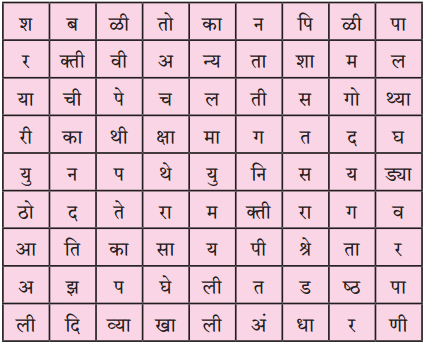
उत्तर :
(१) बळी तो कान पिळी
(२) पालथ्या घड्यावर पाणी
(३) शक्तीपेक्षा युक्ती श्रेष्ठ
(४) दिव्याखाली अंधार
(५) अति तेथे माती
![]()
11th Marathi Book Answers Chapter 12 पैंजण Additional Important Questions and Answers
कृती : २ खालील पठित पदय पंक्तीच्या आधारे दिलेल्या सुचनेनुसार कृती करा.
कृती-१. चौकट पूर्ण करा
प्रश्न 1.
पैंजणाचे वजन :
उत्तर :
दोन किलो
प्रश्न 2.
आजीचं ठुमकणं :
उत्तर :
सम्राज्ञीसारखे
कृती-२. आकृतीबंध पूर्ण करा.
प्रश्न अ.

उत्तर :
a. जखम व्हायची
b. जखम चिघळायची
c. रक्त वाहायचे
प्रश्न ब.
सम्राज्ञीसारखं फिरण्याची जागा : –

उत्तर :
a. स्वयंपाकघर
b. माजघर
| दोन दोन किलो वजनाचे ……………………………………………………………………………………………………………………… राज करायची ! (पाठ्यपुस्तक पृष्ठ क्र. ५३) |
![]()
कृती-३.
प्रश्न 1.
स्वयंपाकघरातून माजघरात,
माजघरातून स्वयंपाकघरात
‘एखादया सम्राज्ञी
सारखी ठुमकत फिरायची!’
यातील तुम्हांला जाणवलेला अर्थ स्पष्ट करा.
उत्तर :
जुन्या काळातील आजीचं अस्तित्व घरापुरतं मर्यादित होतं. घरामध्येही केवळ स्वयंपाकघर, माजघर या ठिकाणीच तिचं अस्तित्व होतं. जे आहे त्यात जुळवून घेण्याचा प्रयत्न त्या काळच्या स्त्रिया करत होत्या. आजीला घरातील स्वयंपाक स्वातंत्र्य होतं. ते सणासुदीला माजघरात वावरण्याचे स्वातंत्र्य होतं.
या दोन खोल्यांव्यतिरिक्त कोणत्याही ठिकाणी तिला जाण्याचे स्वातंत्र्य नव्हतं. पण या ठिकाणी आपल्याला फिरता येतंय. तिथे आपले हक्क चालतायत याच्या अल्प आनंदात एखादया सम्राज्ञीसारखी ती ठुमकत फिरायची. त्या काळात कुटुंब मोठी असायची घरातील ज्येष्ठ स्त्रीला मान असायचा पण निर्णय स्वातंत्र्य नसायचे. त्याबद्दल तिला खेदही वाटत नसायचा.
प्रश्न 2.
आजीला घरात मिळणाऱ्या वागणुकीबद्दल तुमचे मत लिहा.
उत्तर :
माझी आजी गावात राहते. पूर्वी आमच्याकडे एकत्र कुटुंबपद्धती होती. त्यावेळी आजी घरात मोठी सून होती. तिच्यावर बऱ्याच जबाबदाऱ्या असायच्या. कधी तिला माहेरीसुद्धा जायला मिळायचे नाही. पै-पाहुणा घरात आला की सर्वांचे हवे-नको ते पाहण्यात ती मग्न असायची. बाबा-आत्याच्या लहानपणी तिने त्यांना खूप वेळही दिला नाही. पण घरातले सर्वच जण तिचा खूप आदर करत. आगोदर कोणत्याच कार्यात तिचा विचार विचारात घेतला जात नसायचा.
पण जसजसे तिचे वय वाढत गेले तसतसं तिच्या मायेची निर्णयक्षमतेची, समंजसपणाची ख्याती घरभर पसरली तेव्हा तिच्या मतांचा आदर केला जाऊ लागला. माझ्या सर्व काकुंना तिने फार प्रेमानं वागवलं आणि आईचा सासू म्हणून कधी जाच केला नाही.
सर्वांना समजून घेण्यात ती कधीच कमी पडली नाही. त्यामुळे घर दुभंगलं नाही. तिने खूप खस्ता खाल्ल्या घराच्या जबाबदाऱ्या पेलताना; पण आज मात्र ‘काका-काकू, आत्या-मामा, पणजीदेखील तिला फार जपतात. ती सर्वांसाठी प्रेम बरसणारी आहे. तिला खरोखर सन्मानाने वागवले जाते.
पैंजण Summary in Marathi
पैंजण प्रस्तावनाः
नीलम माणगावे कवयित्री लेखिका, संपादिका, बालसाहित्यकार म्हणून परिचित असलेल्या लेखिका. त्यांची आजवर ६० पुस्तके प्रकाशित झाली आहेत. आकाशवाणीवरून त्यांनी कौटुंबिक श्रुतिकालेखन केलं आहे. त्यांच्या कवितांचा गाभा स्त्री हा असतो. स्त्रीवादी जाणीवा त्यांच्या कवितेतून प्रकट झालेल्या दिसतात. बाईपणाची वेदना, कल्लोळ, असोशी कवितेच्या मूळ गाभा असलेल्या दिसतात. कवितेची भाषा सहज, सोपी आहे. अलंकारांचा, प्रतीक, प्रतिमांचा सोस नसलेली त्यांची कविता असल्यामुळे ती सहज उलगडत जाते. गुलदस्ता , ‘शतकाच्या उंबरठ्यावर ‘जाग’ हे कविता संग्रह ‘तीच माती तेच आकाश’, ‘शांते तू जिंकलीस’, ‘निर्भया लढते आहे’ हे कथासंग्रह, अनेक पुरस्कारांनी सन्मानित केले गेले आहे.
![]()
पैंजण कवितेचा आशय :
कवयित्री नीलम माणगावे यांच्या पैंजण या कवितेत स्त्रीच्या प्रगतीचा आलेखच मांडण्याचा प्रयत्न केला आहे. कवयित्री प्राचीन ते अर्वाचीन काळात स्त्रियांच्या जगण्यात जे बदल झाले आहेत त्याचे वर्णन करीत आहे.
प्राचीन काळातील स्त्री तिला कवयित्री आजी म्हणू पाहते. ही आजी दोन दोन किलो वजनाचे पैंजण घालून स्वयंपाकघरातून माजघरात आणि माजघरातून स्वयंपाकघरात सम्राज्ञीसारखी ठुमकत फिरायची. त्या पैंजणांनी तिचे पाय सुजायचे. ते ओझं सहन व्हायचं नाही . तिचे पायाचे घोटे काळे ठिक्कर पडायचे. कधी जखम झाली तरी तिने पैंजण काढले नाहीत. पैंजणाच्या नादात ती इतकी अडकली की त्या भूलभुलैय्यातून बाहेर न पडता पैंजणाखाली फडके बांधून ती सारे निभवायची. आनंद मानायची.
कवयित्री आपल्या अगोदरच्या स्त्रीच्या पिढीबाबत बोलताना आपल्या आईचा उल्लेख करते. आईने पैंजण घालणे सोडून दिले. नाजूक, हलक्या, तोरड्या घालायला सुरुवात केली. आपल्याच तोऱ्यात ती स्वयंपाकघरापासून ते गच्चीपर्यंत मनमुराद फिरायची. आपल्या आईला जितकं स्वातंत्र्य मिळालं नाही तितकं आपल्याला मिळालं याचा आनंद तिच्या मनी होता. तोरड्या तिच्या पायाला टोचायच्या त्यामुळे साडीचे काठ फाटायचे, दोरे लोंबायचे पण सर्व दुर्लक्षून ती राजाराणीसारखी भिरभिरायची. आनंदात जगायची. आपण या घरात राजाची राणी आहोत या भ्रमात ती असायची.

कवयित्री जेव्हा आपल्या पिढीबद्दल बोलते तेव्हा ती स्वत:चे उदाहरण देते. पैंजण, तोरड्या घालणं तिनं केव्हाच सोडलं. हलक्याशा सँडल, बूट, चपला घालता घालता घरच नाही तर अंगण ओलांडन तिनं घराबाहेर पाऊल टाकलं पण कधी कधी याच चप्पल. बट. सँडल. यांचा त्रास होतो. त्याच्याही जखमा पायाला सोसाव्या लागतात. पण आपण घराबाहेर जातो, पैसे कमवतो, चार लोकांमध्ये आपल्याला सन्मान मिळतो. काही गोष्टीत आपली मतं विचारली जातात, त्याची दखल घेतली जाते याचा आनंद इतका असतो की झालेल्या जखमांकडे ती दुर्लक्ष करते.
![]()
कवयित्रीची मुलगी तर त्याही पुढचा विचार करते. पैंजण, तोरड्या तर नकोतच तिला. चप्पल, बूट, सँडलही नको. त्यांचं पकडणं, घसरणं नकोच.
पायाखालचे काटे मोडण्याइतपत पायच पोलादी, मजबूत, घट्ट व्हायला हवेत, पुढच्या शतका आधी हे झालं तर उत्तमच आहे.
पैंजण समानार्थी शब्द / पर्यायी शब्द :
पैंजण – पायातील दागिना (a silver ornament (for the ankles), माजघर – घराचा मध्यभाग, वापरायची खोली (the central portion of a house), सम्राज्ञी – राज्यावर हक्क असणारी राणी (queen), ठुमकत – नादाचा एक प्रकार, (लचकत, मुरडत) भूलभुलैय्या – चक्रव्यूह (circular, confusing military array), फडके – कपडा (cloth), तोरड्या – पायातील कडे(Ornaments for the nakles), पोलादी – पोलाद हा मजबूत धातू आहे. त्यापासून तयार झालेले विशेषण(firm, stern), ऊब – उष्णता (warmness) हद्दपार – सीमेच्या बाहेर(deported).
Marathi Yuvakbharati 11th Digest Text Book Solutions
- ‘माणूस’ बांधूया! Class 11 Marathi Textbook Solutions
- ऐसीं अक्षरें रसिके Class 11 Marathi Textbook Solutions
- वहिनींचा ‘सुसाट’ सल्ला Class 11 Marathi Textbook Solutions
- शब्द Class 11 Marathi Textbook Solutions
- वाङ्मयीन लेण्याचा शिल्पकार Class 11 Marathi Textbook Solutions
- पैंजण Class 11 Marathi Textbook Solutions


















